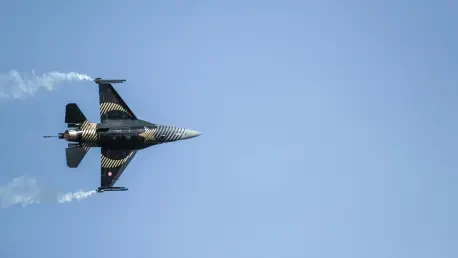Imagine a nation on high alert, its skies buzzing with fighter jets as missiles strike a neighboring country just beyond its borders, a reality Poland faces as a frontline NATO member grappling with the spillover of Russian military actions in Ukraine. As tensions escalate along NATO’s eastern flank, the urgency to protect Polish airspace has never been more critical. This roundup brings together diverse opinions, strategic insights, and expert analyses to explore how Poland is defending its skies against Russian provocations. From rapid military responses to international alliances, the discussion aims to shed light on the multifaceted approaches shaping Poland’s security posture in a volatile region.
Immediate Tactical Responses to Secure the Skies
Jet Scrambles and Air Defense Readiness
Poland’s swift deployment of fighter jets stands as a cornerstone of its immediate defense strategy. On a recent morning, as Russian strikes targeted Ukrainian regions near the border, Polish forces, alongside allied aircraft, took to the skies to safeguard national airspace. Military officials reported that heightened radar and air defense systems were activated, with operations returning to standard levels by early morning. This rapid response showcases Poland’s commitment to maintaining vigilance, though some analysts argue that the frequency of such missions risks straining resources over time.
The efficiency of these operations highlights a well-coordinated system, yet it also raises questions about sustainability. Defense strategists point out that while jet scrambles are effective in signaling resolve, they demand significant logistical support and pilot readiness. A growing concern among military planners is whether repeated activations might desensitize both the public and adversaries to the gravity of these actions, potentially undermining their deterrent effect.
Balancing Deterrence with Risk of Escalation
Differing views emerge on the broader implications of these tactical moves. Some military experts emphasize that showcasing strength through immediate jet deployments sends a clear message to Russia about Poland’s defensive capabilities. However, others caution that such frequent mobilizations could be perceived as provocative, possibly inviting more aggressive Russian maneuvers. This debate underscores a delicate balance between deterrence and the risk of unintended conflict.
A separate perspective focuses on the integration of technology in these responses. Analysts suggest that Poland’s reliance on advanced radar systems enhances its ability to detect threats early, but there is a call for even greater investment in real-time data sharing with allies. The consensus among many is that while Poland’s current tactics are robust, they must evolve to address the unpredictable nature of modern aerial threats.
Navigating Provocations and Drone Incursions
Assessing Intent Behind Russian Drone Violations
Alleged Russian drone incursions into Polish airspace have sparked heated discussions among policymakers and security experts. Many within NATO circles view these incidents as deliberate tests of alliance resolve, designed to probe weaknesses in border defenses. Polish authorities have taken a firm stance, rejecting suggestions that such violations might be accidental, and have responded by downing intruding drones when necessary.
This hardline approach has its supporters, who argue that decisive action is essential to maintain credibility. However, a segment of international observers warns that shooting down drones, while justified, carries the risk of miscalculation. The potential for escalation looms large, especially given Russia’s consistent denial of responsibility for these incursions, which complicates diplomatic efforts to de-escalate tensions.
Strategic Implications of Defensive Actions
The strategic fallout from these incidents draws varied opinions. Some defense analysts contend that Poland’s actions reinforce its role as a steadfast NATO member, willing to confront provocations head-on. Others, however, highlight the need for a measured response, suggesting that overreaction could play into Russia’s hands by justifying further aggression. This dichotomy reveals the complexity of managing border security in a high-stakes environment.
An additional viewpoint stresses the importance of public perception in these scenarios. Security commentators note that consistent communication from Polish leaders about the nature of these threats helps maintain domestic support for defensive measures. Yet, there is a lingering concern that prolonged tensions might erode public patience, pushing for more aggressive or diplomatic solutions depending on political currents.
Long-Term Defense Enhancements with Allied Support
Bolstering Capabilities Through US Missile Deals
Poland’s recent acquisition of Javelin missile systems through a substantial $780 million deal with the United States marks a significant step in fortifying long-term defenses. This agreement, encompassing thousands of missiles and associated support, is widely seen as a boost to Poland’s anti-armor capabilities and its standing within NATO. Many defense industry leaders view this as a pivotal move to deter potential ground-based threats along the eastern border.
However, opinions differ on the broader impact of such deals. While some strategists argue that advanced weaponry strengthens Poland’s position as a regional security anchor, others question whether military hardware alone can address the root causes of Russian aggression. There is a call for complementary diplomatic initiatives to ensure that these investments do not inadvertently heighten tensions.
Weighing Military Buildup Against Diplomatic Needs
A contrasting perspective focuses on the geopolitical ripple effects of Poland’s militarization. Certain policy analysts suggest that while the missile systems enhance deterrence, they might also signal to Russia a more confrontational stance, potentially undermining peace talks. The challenge lies in balancing military readiness with efforts to engage in dialogue, a point of contention among European think tanks.
Another angle considers the economic implications of such large-scale defense spending. Some financial experts express concern over the allocation of national resources toward military acquisitions at the expense of other sectors. They advocate for a transparent assessment of how these investments align with Poland’s broader security and economic priorities, ensuring a holistic approach to national defense.
Collaborative Efforts with NATO and EU Partners
Unified Defense Through Shared Intelligence
Poland’s deepened cooperation with NATO and the EU forms a critical pillar of its airspace defense strategy. Joint exercises and shared intelligence have become hallmarks of this collaboration, reflecting a collective resolve to counter Russian provocations. Many security specialists commend this unified front, noting that it amplifies Poland’s ability to respond to threats with the backing of a powerful alliance.
Comparisons with other NATO border states reveal both similarities and differences in approach. While countries like the Baltic states also prioritize collective defense, Poland’s proximity to active conflict zones in Ukraine places it under unique pressure. Analysts suggest that Poland’s experience could serve as a model for integrating national and allied resources to address immediate security challenges.
Future Directions for Alliance Strategies
Looking at potential developments, there is speculation among defense thinkers about how NATO might further streamline rapid response mechanisms. Some propose the establishment of permanent joint air patrols along the eastern flank to reduce reaction times. This idea, while promising, faces hurdles related to funding and political consensus among member states, highlighting the complexity of alliance dynamics.
An alternative viewpoint emphasizes the role of EU-specific initiatives in complementing NATO efforts. Certain policy experts argue that economic sanctions and political pressure, orchestrated through EU channels, can reinforce military strategies. This dual approach, blending hard and soft power, is seen as a way to build a more resilient defense framework for Poland and its neighbors.
Key Takeaways from Diverse Defense Perspectives
Reflecting on the insights gathered, Poland’s airspace defense emerges as a multifaceted endeavor, blending rapid jet scrambles, decisive action against drone incursions, strategic missile acquisitions, and robust allied cooperation. Each approach carries its own set of challenges and benefits, as highlighted by varying expert opinions. The debate over balancing military strength with diplomatic outreach remains a central theme across discussions.
A notable lesson is the importance of adaptability in responding to evolving threats. Security analysts consistently point to the value of real-time monitoring and technological upgrades as essential components of Poland’s strategy. These elements, paired with international solidarity, offer a blueprint for other nations facing similar border insecurities.
Moving forward, a practical next step involves advocating for integrated defense systems that combine national and allied capabilities. Policymakers and readers alike are encouraged to support initiatives that bolster NATO’s eastern members through funding, training, and policy alignment. Exploring further resources on collective security and regional stability provides an avenue to deepen understanding and contribute to lasting peace in Eastern Europe.









